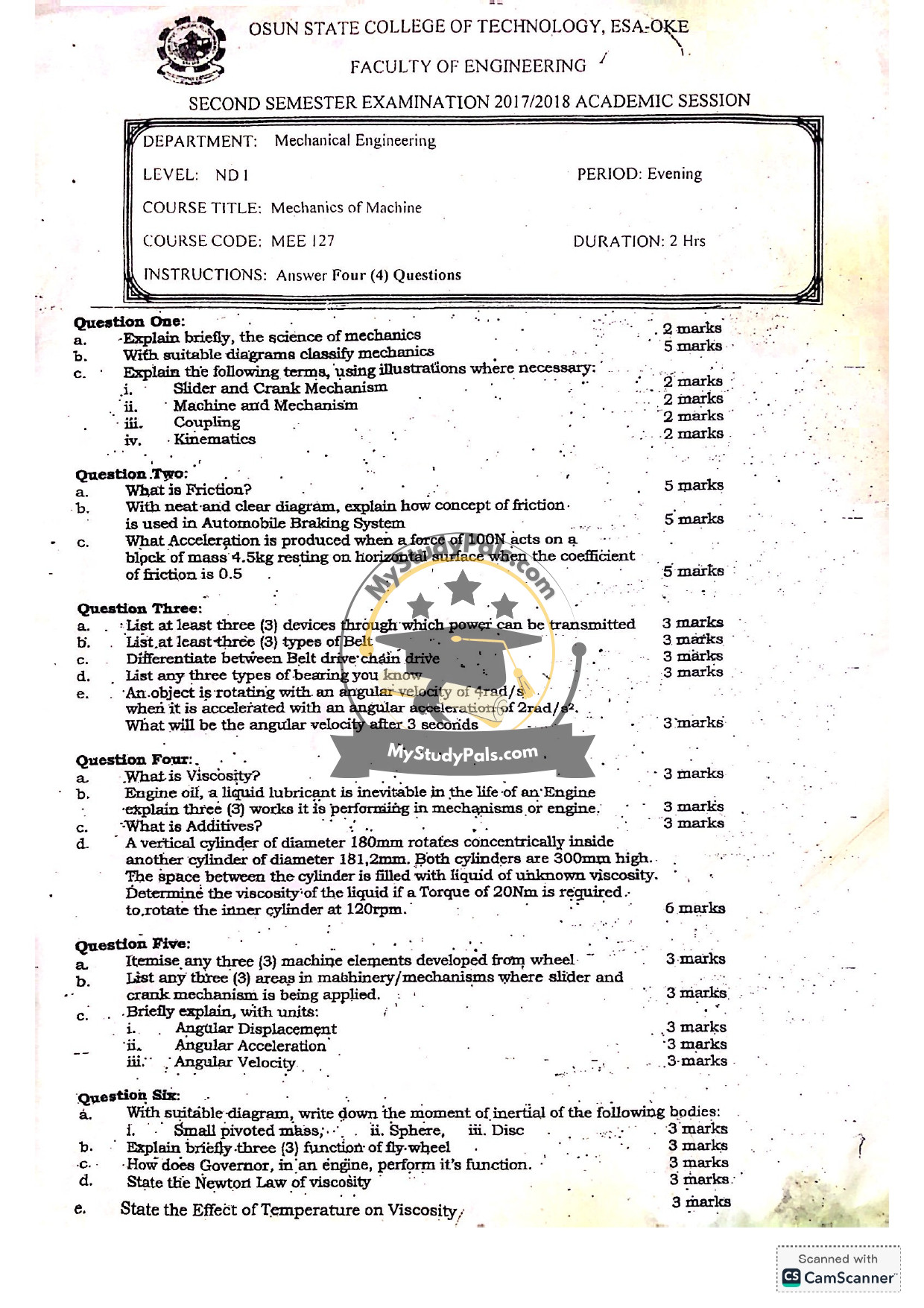ANWSER
—
### Question One:
a. The science of mechanics is a branch of physics that deals with the behavior of physical bodies when subjected to forces or displacements, and the subsequent effects on their motion. It is divided into statics (study of bodies at rest) and dynamics (study of bodies in motion).
b. Classification of Mechanics:
– Statics: Deals with bodies at rest or in equilibrium.
– Dynamics: Deals with bodies in motion, further divided into:
– Kinematics: Study of motion without considering forces.
– Kinetics: Study of motion considering the forces causing it.
c.
i. Slider and Crank Mechanism: A mechanical system that converts linear motion (slider) into rotational motion (crank) or vice versa, commonly used in engines.
ii. Machine and Mechanism:
– Machine: A device that transmits or modifies energy to perform work (e.g., engine).
– Mechanism: A system of parts working together to produce motion (e.g., gear train).
iii. Coupling: A device used to connect two shafts for transmitting power (e.g., rigid or flexible coupling).
iv. Kinematics: The study of motion of objects without considering the forces causing the motion.
—
### Question Two:
a. Friction is the resistive force that opposes the relative motion or tendency of motion between two surfaces in contact.
b. In an automobile braking system, friction is used to convert kinetic energy into heat. When the brake pedal is pressed, brake pads (friction material) clamp onto the rotating disc (or drum), creating friction that slows down the vehicle.
c. Given:
Force \( F = 100N \), Mass \( m = 4.5kg \), Coefficient of friction \( \mu = 0.5 \).
Frictional force \( F_f = \mu \times N = 0.5 \times (4.5 \times 9.81) = 22.07N \).
Net force \( F_{net} = F – F_f = 100 – 22.07 = 77.93N \).
Acceleration \( a = F_{net}/m = 77.93/4.5 = 17.32 \, m/s^2 \).
—
### Question Three:
a. Devices for power transmission:
1. Gears
2. Belts and pulleys
3. Chains and sprockets
b. Types of belts:
1. Flat belt
2. V-belt
3. Timing belt
c. Belt drive vs. Chain drive:
– Belt drive is quieter and smoother but can slip.
– Chain drive is more durable and precise but noisier.
d. Types of bearings:
1. Ball bearing
2. Roller bearing
3. Thrust bearing
e. Angular velocity \( \omega = \omega_0 + \alpha t = 4 + (2 \times 3) = 10 \, rad/s \).
—
### Question Four:
a. Viscosity is a measure of a fluid’s resistance to flow or deformation under shear stress.
b. Functions of engine oil:
1. Reduces friction between moving parts.
2. Cools the engine by dissipating heat.
3. Cleans the engine by carrying away contaminants.
c. Additives are chemicals added to lubricants to enhance their properties, such as anti-wear or anti-oxidation.
d. Given:
Torque \( T = 20Nm \), Speed \( N = 120rpm \), Gap \( h = (181.2 – 180)/2 = 0.6mm \).
Viscosity \( \mu \) is calculated using \( T = \mu \cdot (2\pi r^2 L \omega)/h \).
Solving gives \( \mu \approx 0.113 \, Pa \cdot s \).
—
### Question Five:
a. Machine elements derived from the wheel:
1. Gears
2. Pulleys
3. Flywheels
b. Applications of slider-crank mechanism:
1. Internal combustion engines
2. Pumps
3. Compressors
c.
i. Angular Displacement: Change in angular position (radians).
ii. Angular Acceleration: Rate of change of angular velocity (\( rad/s^2 \)).
iii. Angular Velocity: Rate of change of angular displacement (\( rad/s \)).
—
### Question Six:
a. Moments of inertia:
i. Small pivoted mass: \( I = mr^2 \)
ii. Sphere: \( I = \frac{2}{5}mr^2 \)
iii. Disc: \( I = \frac{1}{2}mr^2 \)
b. Functions of a flywheel:
1. Stores rotational energy.
2. Smoothens engine operation.
3. Reduces fluctuations in speed.
c. A governor regulates engine speed by adjusting fuel supply based on load changes.
d. Newton’s Law of Viscosity: Shear stress is proportional to the velocity gradient (\( \tau = \mu \frac{du}{dy} \)).
e. Effect of temperature on viscosity:
– Liquids: Viscosity decreases with temperature.
– Gases: Viscosity increases with temperature.
—


